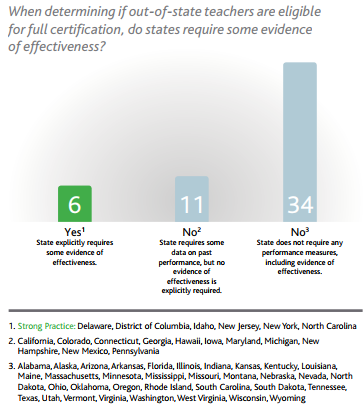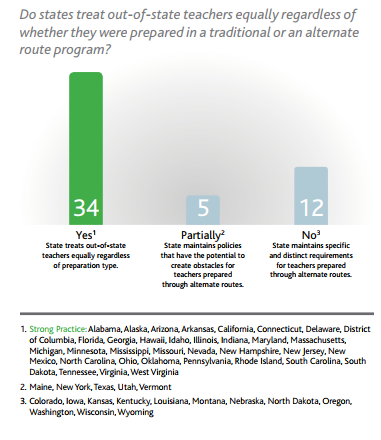As many states struggle to staff all their classrooms, they might want to examine the degree to which their own policies discourage qualified teachers from applying.
A recent working paper by Janna Johnson and Morris Kleiner of the University of Minnesota suggests that states’ licensure requirements are indeed restricting their access to teachers who might otherwise consider moving from another state.
The study, which compares the rates at which members of licensed and non-licensed occupations move across state lines, found that teachers move between states at rates that are almost 40 percent lower relative to other occupations, despite controlling for factors that motivate long-distance moves across all occupations.
It is certainly appropriate for states to employ certain safeguards when it comes to issuing licensure to out-of-state teachers, such as verifying that teachers meet background checks and asking for evidence of solid work performance in the previous state. Anything further effectively sets up a barrier wall around the state, dissuading much-needed talent from entering the state’s teacher workforce.
Unfortunately, too many states are still upholding cumbersome, and often costly, requirements beyond what is needed to ensure effectiveness, while failing to enact the requirements that do matter.
Data from NCTQ’s 2017 State Teacher Policy Yearbook found that only six states make the sensible decision to require out-of-state teachers to present evidence of effective teaching, while many more (19) continue to impose additional—and often burdensome–requirements such as added coursework or professional development hours.

Many states make it even more difficult for out-of-state teachers who were prepared by an alternate route program, maintaining what look to be discriminatory requirements for non-traditionally certified teachers.

The barriers are particularly consequential for schools and districts located near state borders, where a significant portion of the local talent may live just on the other side of the state line, but are out of reach because teachers are unwilling to take more coursework or additional rounds of testing just to prove their mettle to the neighboring state. In fact, research previously highlighted here has found that student achievement suffers when schools are located near state lines.
More like this

Trained but sidelined: how schools are missing out on mid-career teachers

Good intentions, worrisome results: The impact of emergency teacher licensure in Massachusetts

Not so fast! Why emergency teacher licenses fall short

